In natural disasters, disasters of a meteorological nature account for a large proportion. After the occurrence of any natural disaster, the public opinion is often focused on this issue: is it actually a natural disaster or a man-made disaster? This is involved with the issue of risk management.
The following key points will be discussed: With Shanghai being a megacity, what is the situation with regard to the risk of meteorological disasters? In response to urban meteorological disasters, what sorts of good practices have been put in place and what information has been accumulated in Shanghai during its process of transition to risk management? How do we promote the next step?
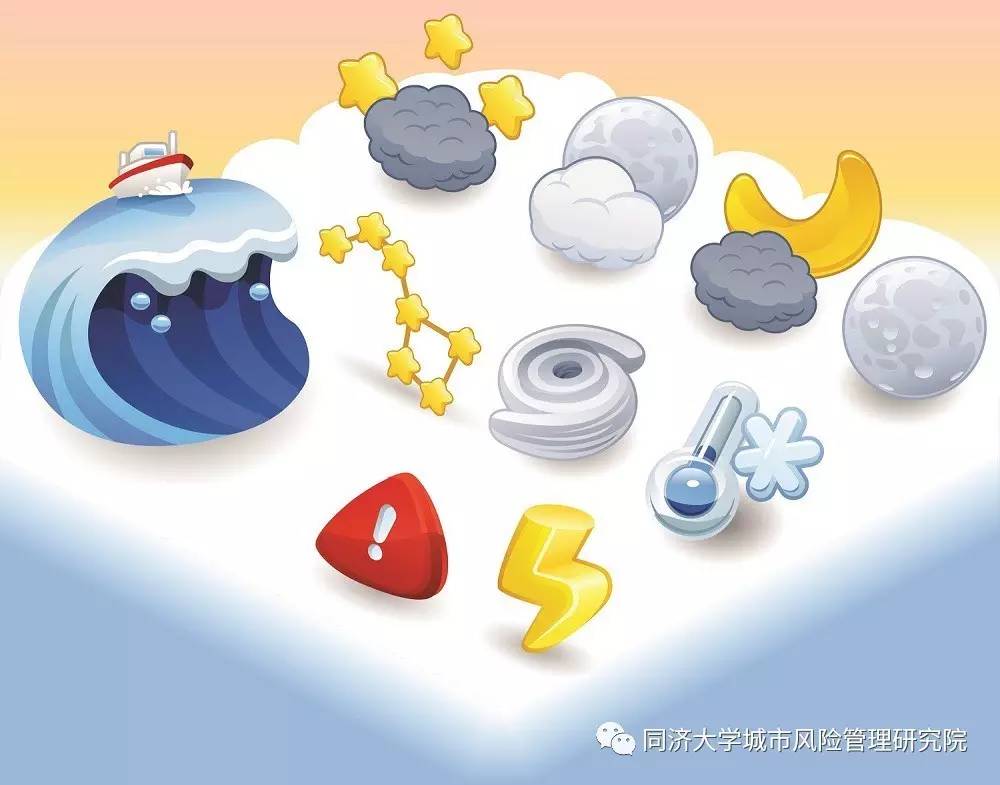
Risk assessment of meteorological disasters in Shanghai
According to the statistics of the United Nations World Meteorological Organization (WMO), meteorological disasters accounted for 60% of the total number of natural disasters worldwide. In China, the ratio is over 70%. The annual loss caused by meteorological disasters is very large, including both property damage and personal casualties.
In general, meteorological disasters in Shanghai have five features:
First of all, the possibility of meteorological disasters on Shanghai is all year round. In the first half of the year, there are typhoons, rainstorms, strong convection and high temperature heat waves. Throughout autumn and winter, there are hazes, low temperatures, freezing rains and snows, and so on. Meteorologists never neglect their duties throughout the year, and they busily engage in their work with due diligence.

The second feature is floods, typhoons, thunder and lightning, which are the three most frequent disasters.
The third feature involves losses. In Shanghai, typhoons cause the greatest economic losses, while lightning strikes cause the greatest number of personal casualties.
The fourth feature is that urban operation is highly sensitive to meteorological conditions.
According to statistics, if in summer, the daily maximum temperature increases by 1℃, the maximum daily power usage will increase by about 610,000 kilowatts in Shanghai, and water usage will increase by 58,000 cubic meters in the urban center. Shanghai vegetable price fluctuations are caused by meteorological disasters, such as floods, extreme temperatures and so on. Likewise, a large quantity of data on the relationship between outpatient and meteorological conditions found that when the monthly average temperature increases from 29℃ to 30℃, that is to say, it only increases by 1℃, the number of people who die of heatstroke will double.
The fifth feature is that derivative and secondary disasters are particularly serious, as there is a “domino” effect. Typhoon anemone affected Shanghai in 2012, resulting in direct economic losses of more than RMB 500 million. Indirect impact was even greater: There were 782 flights canceled at two major airports, Pudong and Hongqiao. The railway closure accounted for about one hundred trips, and the long-distance passenger bus outage accounted for about 600 trips, and so on.
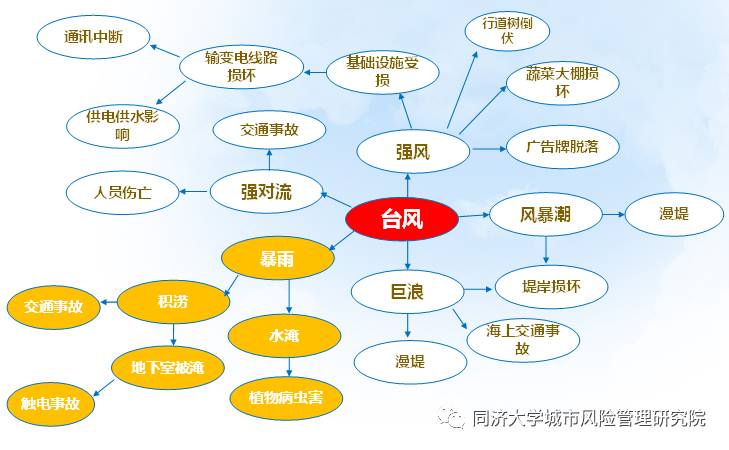
In the future, what is the situation for risk assessment of meteorological disasters in Shanghai?
Due to the dual effects of global warming (now called “climate change”) and urbanization, the average temperature is rising in Shanghai and the urban heat island effect is very significant. It is expected that in the next two decades, extremely cold weather in Shanghai will be reduced in winter, but the number of extremely hot days will increase in summer. According to analysis of the data, it is found that the annual average temperature in Shanghai increased from the year 1673 to 2015, and the average temperature increases by 0.16℃ every decade. Since the late 1990s, the warming tendency has been particularly significant. The average high temperature days in the urban center are nearly 12 days more than that of the eastern coast of China. The heat island effect is obvious.
Regarding rainfall, the annual number of days with light rain is decreasing, but the number of days with heavy rain and rainstorm is increasing. This rain island effect is becoming more and more significant. The urban rain island effect means that the rainfall in urban centers is significantly higher than that of the suburbs. On average, the difference is over 100 mm annually. In fact, the stronger the heavy rainfall is, the more likely the urban waterlogging occurs. It is expected that the number of days and the intensity of heavy rainfall will increase over the next two decades.
Likewise, there is the impact of the wind. The average wind speed is becoming weaker and the number of days of strong wind is reducing. This is largely because of urbanization, which means that Shanghai is constantly growing taller and taller to become a “concrete jungle”. When the weather forecast reports a strong breeze (Force Six), it is felt as a very strong wind in the countryside, but it is merely felt as a breeze in Shanghai, because the wind is obstructed by high-rises. As the wind spread is weak, the air diffusion conditions are poor. Therefore, hazy weather is becoming more and more serious, which is known as the so-called turbid island effect in the city.

The last feather is the problem of the rising sea level. The steadily rising sea level has exacerbated storm surge disasters. Rising sea levels caused by global climate change, together with the land subsidence, make the city weak in withstanding floods and disasters, which threaten the safety of the city’s water supply. It is predicted that sea levels will continue to rise in the next two or three decades. This is a very real threat to the coastal megacity of Shanghai.
Based on the matrix analyses of risk assessment of the future climate change in Shanghai, combined with the specific assessments of traffic, hydropower, energy and the ecological environment, it has been discovered that the urban traffic sector in the future is anticipated to face a higher risk of disasters, such as typhoons, rainstorms, cold waves, storm surges and/or haze.
Risk Management Practices for Urban Meteorological Disasters: From Weather to Impact
Before introducing the risk management practices of urban meteorological disasters in Shanghai, let us talk about our development ideas:
I. Conversion from traditional weather forecasting to impact forecasting and provide risk early warnings
This conversion is to be from the general weather forecast (with fixed weather thresholds) to that whereby the thresholds are based on spatiotemporal change first, then to the early weather warning with user-defined thresholds, and finally to the impact forecasting and risk early warning. These conversions mean that another step forward has been taken on the basis of the original division of labor. This step forward should not be underestimated. It is not easy to take this step forward because it involves dedication and the responsibility.
In this conversion, the technical difficulty is increased for each step forward, and close cooperation with the relevant departments is required for each step forward. Thereafter, the requirements for data fusion needed for disaster early warning will be higher than that of the previous step. However, from the viewpoint of development of urban risk management, we have to take that step forward.
As for traditional forecasting, if it forecasts heavy rain tomorrow, a threshold as to how many millimeters of rainfall in 24 hours is given, and this value is fixed. It is quite different from early weather warning. Based on spatiotemporal changes, the threshold is no longer fixed, but is constantly changing. For example, if the rainfall is 100 mm today, how much rain will fall tomorrow, if it keeps on raining? The result of 100 mm rainfall in this situation is quite different from 100 mm rainfall in dry conditions. On the other hand, thresholds are distinguished for different objects. The same weather will have different impacts due to different users and different areas. An unusually light rain of 2 mm per an hour may cause Shanghai’s early peak traffic to become paralyzed, but if this amount of light rain falls in other areas, it may cause no adversity.
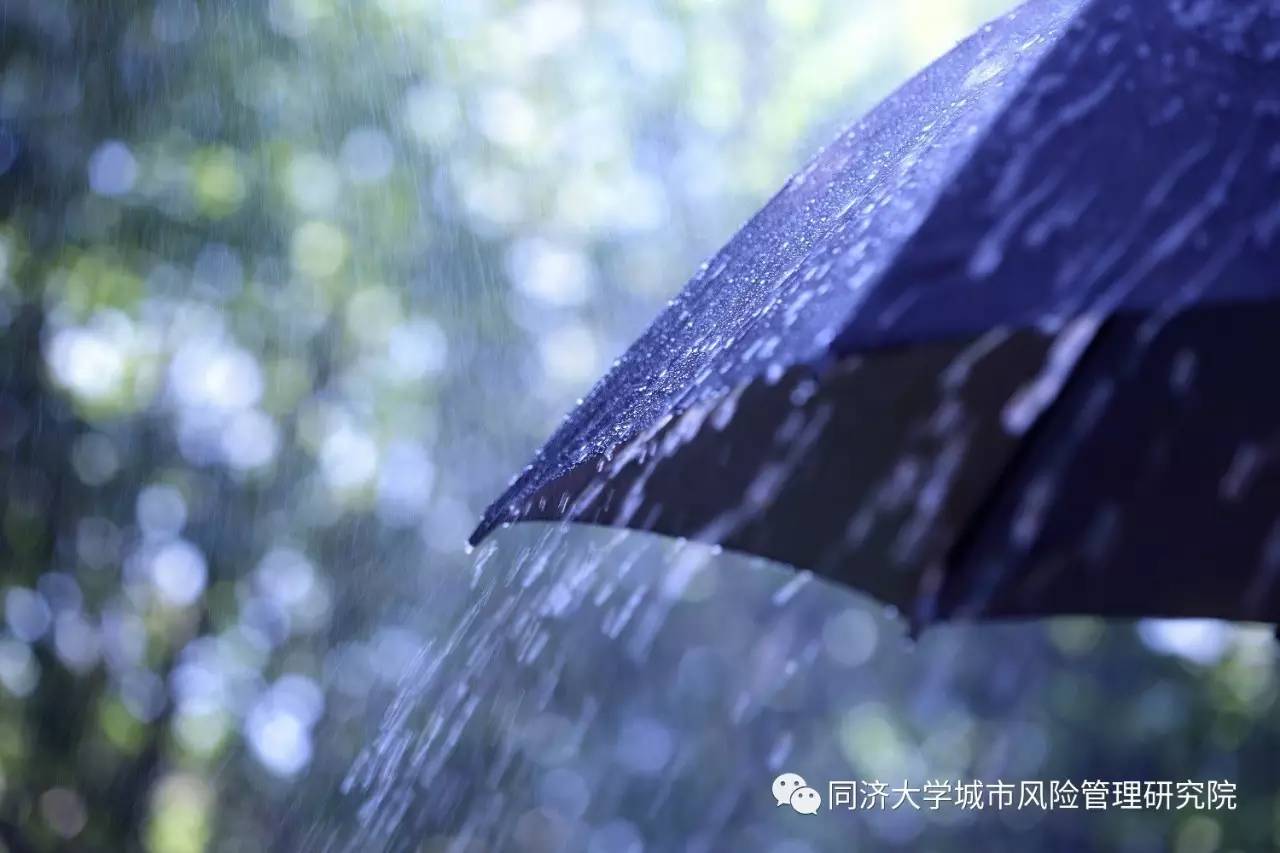
II. Impact-based forecasting and early warning require full interaction between meteorological departments and users
Early weather warnings based on spatiotemporal changes and user-defined thresholds need to be further developed into impact forecasting and risk early warning. Impact forecasting and risk early warning are divided into four main steps. The first step is to refine the elements of weather forecasting. The next step is through the relevant data mining analyses to carry out impact forecasting. The following step is to remind and carry out risk warning according to endurance. The final step is response linkage and disaster relief.
With regard to the degree of participation in these four steps, the meteorological department is much more involved in the first few steps, and gradually less and less involved. Conversely, the trend for users is from less to more. In combination, the impact-based forecast and early warning service is a new type of interactive forecasting service which combines with users' bearing capacity and decision-making processes. The abovementioned four steps for core business need meteorological departments and service recipients to be fully involved and cooperate with each other. Real-time and non-real-time operations are involved here. All business units and departments should strengthen their cooperation and make good preparations.
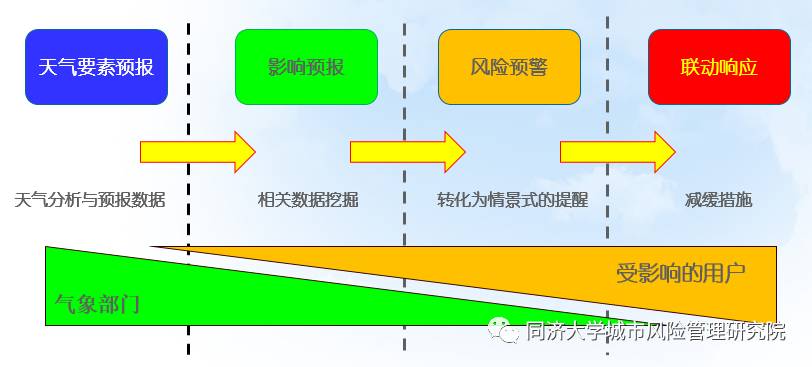
III. Impact-based forecast and the need for early warning has forced the conversion of the traditional meteorological service.
1. Regarding the forecast connotations, it is converted from the forecast of traditional weather factors to the impact forecasting of the industry.
2. Regarding the forecasting ideas, it is converted from the deterministic forecast to the uncertainty forecast.
People may not understand this. Is the weather forecast not getting more and more accurate? How can it regress from certainty to uncertainty? This is a scientific issue. It can be quite certain to forecast whether it rains or not tomorrow without mentioning the details. However, with the improvement of scientific and technological levels, we can tell the residents that the probability of rain tomorrow is 30%, 70%, or 80%. In fact, this uncertainty shows that it is more accurate and certain in a scientific way.
3. Regarding the release of early warnings, in the past it was released based on fixed weather indicator thresholds. But, it will be released based on risk impact thresholds in the future.
4. Regarding the conversion of the service mode, in the past it was merely a simple forecast released, and no more else would be done. In the future, the weather forecast will be closely linked with the user's decision-making process, and the user will consider climate changes in the decision-making process.
Practical cases
Rail transportation
Shanghai Metro Line 2 and Line 16 run along the river and the coast, and they also run on the ground. So, their normal operations are affected by strong winds. According to the concepts in the past, only Strong Breeze (Force Six) or Near Gale (Force Seven) was forecast. The question, then, is whether it would affect the carriages. This question cannot be answered with only a provided weather forecast. Shanghai Meteorological Bureau and Shanghai Shentong Metro Group Co., Ltd. (SSMG) have cooperated to study what levels and direction of wind would have an impact on the safe operation of subway cars. A set of impact thresholds and special early warnings have been developed, which are called, “Rail Transit Impact Forecast and Risk Early Warning” system. Currently, the system has applied strong wind forecasting and risk warning services to the sections along the track of Shentong Metro Line 16 and Line 2. On Metro Line 16, when the wind reaches the preset warning level, the train will automatically stop at the instant.
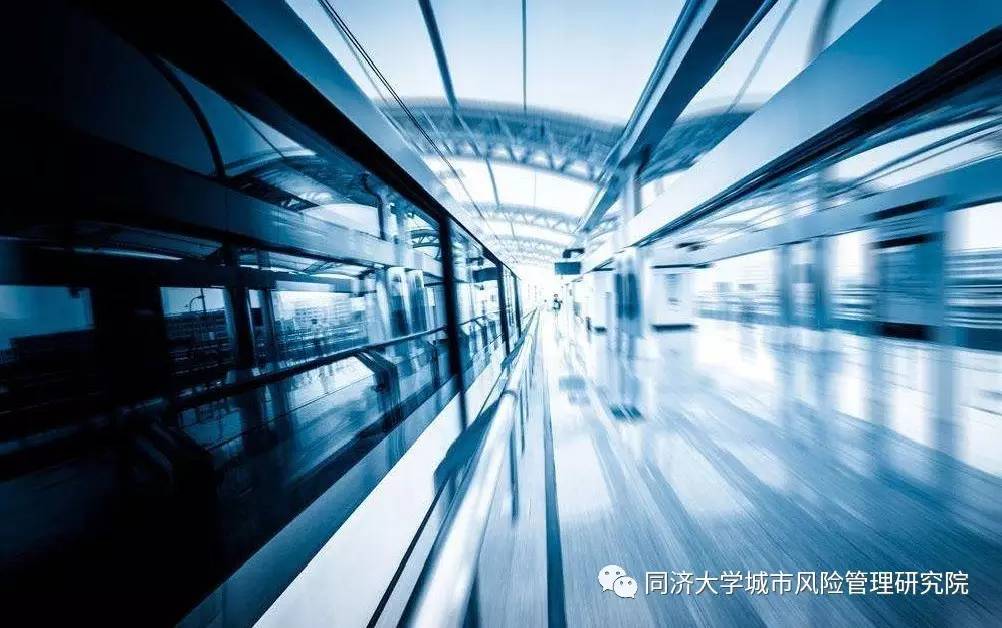
Health and meteorology
Based on the monitoring and forecasting information of weather, climate and atmospheric environments, combined with the impact mechanism of disease occurrence and pathology, the weather service for health has been produced and released to the public and specific departments. Four types of weather services have been released: Risk forecast of heatstroke, risk forecast of influenza, risk forecast of childhood asthma, and risk forecast of chronic obstructive pulmonary disease (COPD). Products for users to make appropriate decisions are being developed, such as "Report on Health Risk Assessment of Severe Pollution" and so on.
Urban waterlog
With all aspects of support, we have developed a number of urban waterlogging forecast models. It is a typical impact forecasting and risk early warning. It has integrated the accurate weather forecast with the threshold values and risk assessments. Then, the impact forecasting and risk early warnings are released to the communities and emergency grid cells to take corresponding measures.
In the past, most of the early warnings were ineffective. Moreover, they merely disturbed the residents, because of strong wind orientation and the wind force. Currently, it is released directly to the area susceptible to impact, and potential waterlogging warnings are directly released to some communities. The number of early warnings has been reduced by half, and the timeliness of these has doubled.
Shanghai was affected by Typhoon Chan-Hom in July 2015, and an early warning was directly released to Yangpu District. It was very effectively communicated through emergency management units, network management units, community created clients, WeChat public accounts and other direct information services.
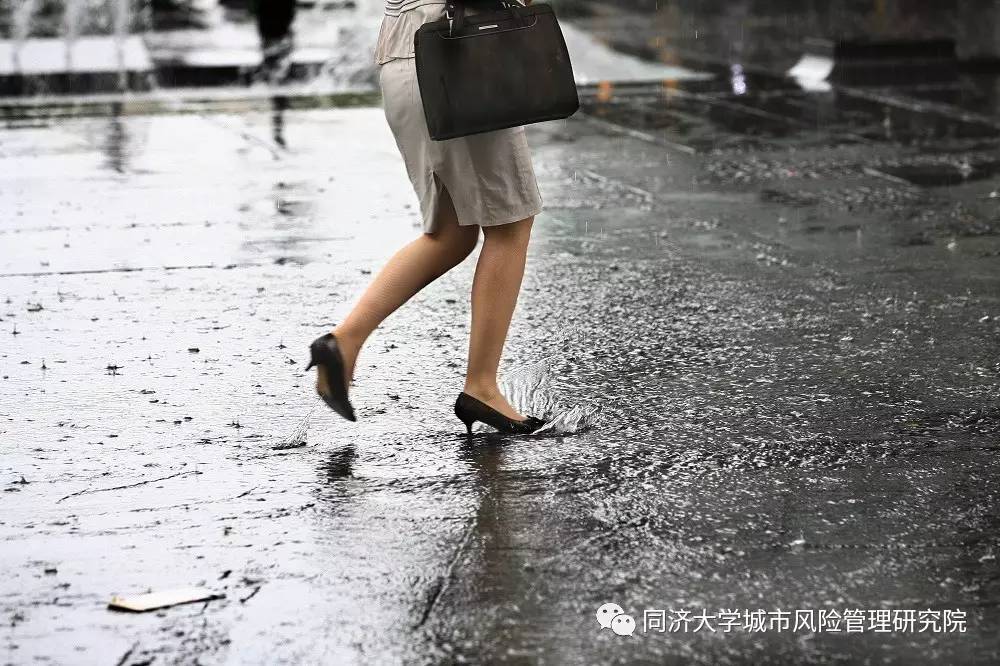
Marine meteorology
Shanghai is a global “super harbor”, and our marine meteorological service is also very significant. In 2014, a container ship capsized near the Yangshan Port. The vessel was loaded with cosmetics, which caused chemical reactions when they were soaked in water, sustaining heavy losses. At that time, the wind was not very strong (i.e. Strong Breeze or Force Six). Generally speaking, it would not cause a ship to capsize. In fact, the capsizing of a ship is related to the size of the ship, the amount of goods loaded, the category of goods, the degree of wave tilting and rolling, and other factors. Therefore, the weather service cannot rely on a single meteorological element, and it must be combined with the ship and the hazard-affected body to find out hidden risks. Thereafter, according to the statistical analysis, it was discovered the ship’s capsize was largely due to the degree of wave tilting and the effects of the shoal.
Based on the marine meteorological monitoring and warning service platform, the grid impact forecasting and risk warning data have been compiled. The marine meteorological impact forecast reports and risk warning signals are broadcast in real time through the ship automatic identification system AIS shore station, and it can be received and analyzed by the AIS receiving device on the ship. Thus, the latest weather service information can be obtained.
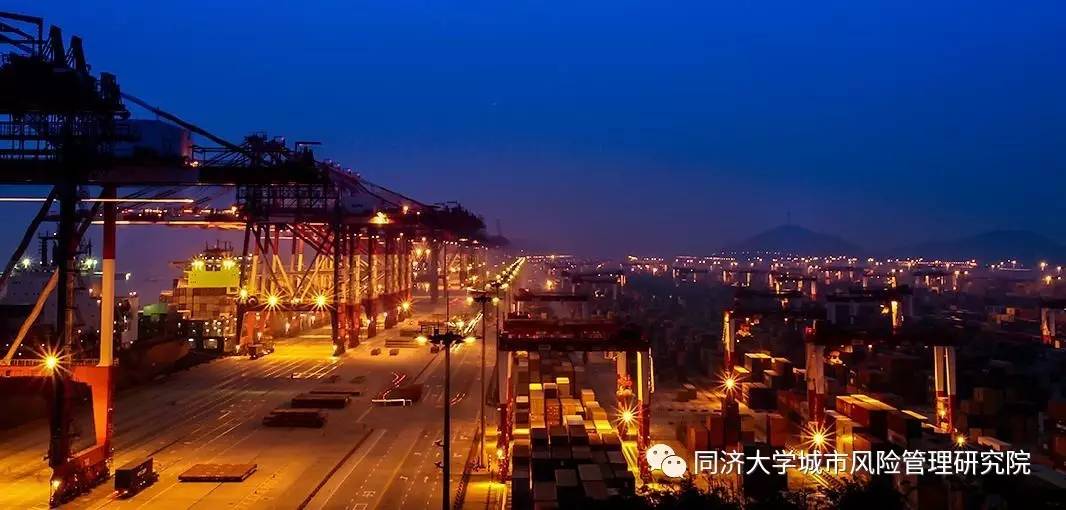
Aviation meteorology
The Shanghai Meteorological Bureau has also cooperated with airports and airlines to provide aviation weather forecasting and risk warning.
For example, severe convection weather in summer actually affects the airport in particular. After the refinement, it will greatly improve the efficiency to arrange the closing or opening times, according to the impact forecasting and risk early warning.
Longer-term and wide-ranging aviation meteorological interpretation applications, such as ariport and airway forecasting, have been developed based on the high-resolution EC model. Aviation meteorological impact forecasting service platforms have been set up, and have been put into trial service at Pudong and Hongqiao International Airports.
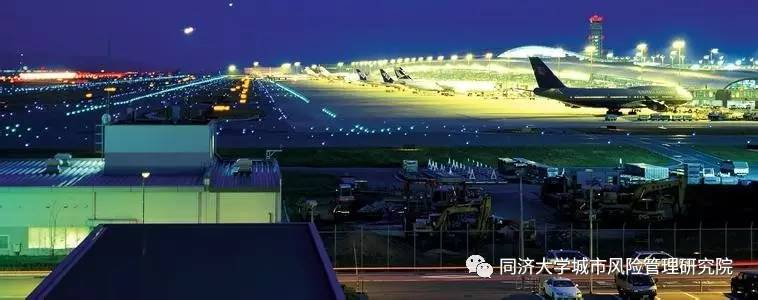
Tasks in the next step
Now we are in the information age. Shanghai has taken the lead nationwide to have accomplished two rounds of its “Smart City” action plan. The construction of “Smart City” has been put on the agenda in the “13th Five Year Plan”. The weather service is also facing the transformation to smart development.

In the future, the meteorological public service will form a strong support to the risk management of meteorological disasters and various derivative disasters which affect the safe operation of the city. The meteorological early warning information will achieve the targeted release and the city-wide coverage. The meteorological industry and other different industries, such as shipping, aviation, environmental protection, tourism and public health, will be deeply integrated and cooperated. The technology of mobile internet and intelligent identification will have been applied thoroughly, and it will basically meet the needs of the public and professional users for personalized service.
It includes a framework, and its core is a large data platform. We must share with others and be open-minded. The meteorological data are among the first to be open to the public.

The first task in the next step is to focus on disaster prevention and mitigation, and to ensure the safety of life and property, as well as to promote economic growth, so as to avoid the negative impact of the weather, which would be a contribution to social stability and social development.
Meteorological departments need to carry out more effective cooperation with disaster prevention and mitigation departments, the public and stakeholders: (1) to predict the impact of severe weather, (2) to obtain meteorological information and impact, (3) to think about what kind of reasonable action should be taken, and (4) to plan engineering measures and system designs. We must improve the whole process of prediction, forecasting, early warning, pre-arranged planning, and prevention. Considering weather and climate together, it not only covers the trend for the next few days, but also the next decade, even the next several decades of climate change. In fact, this is quite a comprehensive climate service.
The second task is to focus on the development of technology. This covers several key points, including forecasting techniques, and exposure concerns on risk early warning, as well as assessment of vulnerability.
The third task is to strengthen the integration of departments. This cannot be accomplished by us alone. It depends on the cooperation and collaboration among departments at all levels.
The fourth task involves the issue of community collegiality. The issue of disaster prevention and mitigation cannot be solved by government alone. Communities, families and individuals are encouraged to take some responsibility. Likewise, social organizations are encouraged to be established for disaster prevention and mitigation, and it is emphasized that enterprises and institutions should play a dominant role in disaster prevention and mitigation.
The last task is to play the role of the insurance in respect to risk transfer as well as in disaster prevention and mitigation. Together with the Insurance Regulatory Bureau, Huangpu District Government and Songjiang District Government, we are now carrying out a pilot program for catastrophe insurance. I believe that the relevant mechanism will be more and more perfect in the future.
Author: Chen Zhenlin, Director General and Party Secretary of Shanghai Meteorological Bureau.


